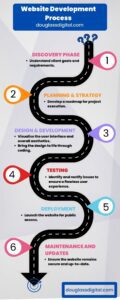Table of contents
- The Website Development Process
- What is Website Development?
- The 6 Steps of the Web Development Process
- Important Tips
- Conclusion
The Website Development Process
Completing a successful website development journey involves crossing different phases.
Every phase is essential for achieving your long-awaited digital presence.
In this blog post, we will discuss the website development process and its steps. We will thoroughly explain what each step means and what are the most common actions taken for those steps.
What is Website Development?
Web development is a term used to describe the complex process of crafting and maintaining websites.
This process involves two primary components:
Front-end Development & Back-end Development
The purpose of front-end development is to shape what visitors see and experience on a website. The most common tools used are HTML for structure, CSS for styling, and JavaScript for interactivity.
The back-end development process involves managing the functionality and data behind the scenes. It uses languages such as PHP, Node.js, and Python to handle databases and server logic.
In essence, web development refers to the creation, improvement, and maintenance of websites, ensuring they are visually appealing, functional, user-friendly, and secure.
The 6 Steps of the Web Development Process
Because planning a website, like other aspects of a business, is an aspect that is systematically planned and executed, there are several steps which need to be achieved before starting the next.
Building a robust strategy that will later be followed and completed will ensure a final product that aligns with the client’s needs and brand.
The Journey of Deployment
- Discovery Phase
- Planning and Strategy
- Design and Development
- Testing
- Deployment
- Maintenance and Updates
Before digging into the written content, we’ve created an infographic to simplify the process.
Let’s go through each of the website development process steps one by one:
Discovery Phase
The Discovery Phase is about getting to know the client’s needs, requirements, and goals.
Here, through interviews and discussions valuable insights about business goals, target audience, and competition are gathered, forming the basis for a customised plan.
This step is crucial because both parties (the service provider and the client) have the chance to get to know each other, set expectations, define timelines and schedules, and develop the overall strategy.
By carefully going through this phase, potential misunderstandings can be minimised.
Planning and Strategy
With all the insights in hand and both parties on the same page, the journey moves to the next step: the Planning and Strategy strategy.
Here, the website’s layout is defined. Usually means that the sitemap and the wireframe are created.
The sitemap is the blueprint of your website. It shows the map of all the pages and how they are connected.
The wireframe is a basic overview of what a webpage will look like. It focuses on the layout and the structure of the pages, without adding other details (colours/images).
This step involves intense collaboration with the client. Careful collaboration provides clients with the opportunity to share their vision and preferences, allowing them to visualise how their ideas will look in the digital realm.
Design and Development
Advancing to the Design and Development step, the focus is on visualising the user interface and overall aesthetics and elements.
After thorough inspection and approval from the client, the development step begins.
A team of developers will start building the website and bring to life the client’s digital presence.
Testing
Quality assurance becomes critical in the Testing phase.
Here, the responsible team carry out tests for issues that might deteriorate the user experience.
Usability tests, site loading speed, responsiveness, and thorough bug fixes to ensure the website meets the highest standards before it’s launched.
Deployment
The much-anticipated Deployment phase arrives, marking the website available for public access.
This phase ensures a smooth transition from development to the live digital environment, representing the completion of meticulous planning and dedicated effort.
Maintenance and Updates
Beyond the launch, the commitment continues through the Maintenance and Updates phase.
Regular checks, security updates, and ongoing support are applied to ensure the website remains secure, up-to-date, and aligned with evolving industry and technological standards.
Tips for clients and agencies
Set Clear Plans and Goals
- Start the website journey with clear plans and goals. Without a plan, it can be hard to know where to start and where you want to end up.
- Avoid the trap of expecting things to magically fall into place. A well-thought-out plan saves time and resources.
Prioritise Mobile-Friendliness
- Think mobile-first! The number of mobile users is growing, so optimise your website for responsiveness. This ensures your site performs well on all devices, giving users a seamless experience.
Simplify Content
- Keep your content simple and straightforward. Your audience comes from diverse backgrounds, and nobody wants to play detective with your content.
- Focus on clarity. Your message should be easily understood without readers having to decipher complex words and phrases.
Get to Know Your Partner
- Building a strong partnership is key. Take the time to know your partner, understand their approach, and share your expectations openly.
- A solid relationship sets the way for a smoother development process, where everyone is on the same page.
Conclusion
Building the ideal, intuitive, and user-friendly website involves more than what meets the eye.
Creating a website is a journey where each step adds to the final result. It’s about bringing ideas to life and adapting to the ever-changing digital world.
Each phase plays a crucial role in ensuring the final product is not only visually appealing and functional but also aligns seamlessly with the client’s needs and brand identity.
Through collaboration and continuous commitment, each step of the website development process transforms visions into impactful online realities.
Further Reads
For more information about web development and design, visit our dedicated pages or our content-rich blog.
Additionally, you can access the following articles for more in-depth reading:
The Beginner’s Guide to Website Development
A Guide to Website Development
Website Development: In-Depth Guide For Beginners
Front-End vs. Back-End Developer
See How We Can Help
Whether you’re in the early stages of discovery, refining your strategy, or seeking design and development, our professionals bring years of experience to the table.
We specialise in creating tailored solutions that align with your unique goals and aspirations.
Explore our services to discover how we can boost your web development experience.
Subscribe to our newsletter for a front-row seat to the latest insights and exciting news.



